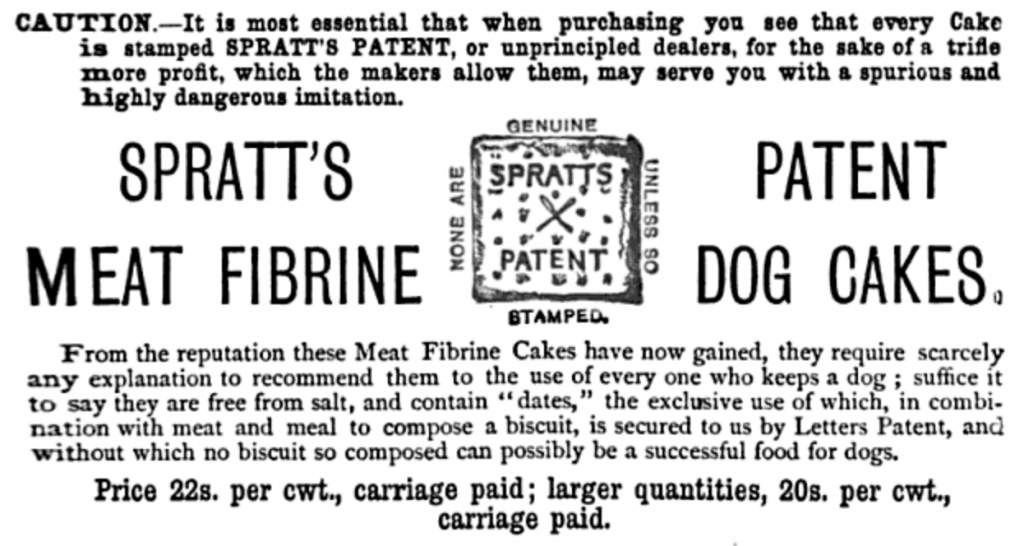Ever wondered how the modern pet food manufacturing process came to be? The first step to inventing the commercial pet food we know today was made in 1860 by an electrician named James Spratt. He gained inspiration seeing stray dogs feeding on leftovers of dry wheat biscuits, that sailors would bring on long trips. The biscuits were widely used because of their low cost and almost infinite shelf-life.
He reasoned that the convenience of a shelf-stable product would be perfect for dog owners, so he set out to create the first official dog biscuit. The product was heavily inspired by the sailor-biscuits and mainly consisted of cheap dry ingredients such as wheat and other grains. Spratt marketed the biscuits as “luxury dog and puppy cakes” allowing him to earn enormous margins while using the same cheap ingredients as before.
New machines; Same ingredients
Many large companies experimented to come up with new ways of manufacturing pet food to grab a bite of the growing market. In 1950, companies started to use extruders to manufacture their food. Extruders were originally invented to manufacture large quantities of puffed cereal but later became the number one method of producing pet food. Today about 95{fa7ba7ae27be3a1686d96d9547a0bc3b37fc6c00ce87729c0a60242ec6a109f4} of all dry pet food is made in same way.
The process involves mixing ingredients to a dough-like texture and forcing them through a die while being heated to extreme temperatures using high pressure and steam. This allows for large quantities of pet food being made in a very short time.
There was only one problem: the machines were designed to make cereal – not pet food. While the output was high, the process would significantly lower the nutritional value of the ingredients.
Only highly-processed allowed
Extrusion-made pet food was regarded as one of the most groundbreaking technologies at the time but was still bound by the same restrictions set a hundred years before. No matter how many improvements there was made on the machines, they all had one major flaw; they couldn’t handle large inclusions of fresh meat and vegetables. The machines could only function effectively using dry ingredients.
Since people gained more knowledge on dog nutrition, more consumers began requesting meat on the labels. But instead of changing the manufacturing method, they simply invented new ingredients that would work on the large machines. Fresh meat was replaced with high rendered meat meals. Vegetables were replaced with ground corn or rendered plant protein and proper nutrition was replaced with artificial vitamin pre-mixes. All in order to keep the moisture content low enough to manufacture at large scale. Even some pet food products marketed as “super-premium” are made without a single fresh ingredient.
This is why so many ingredients on normal pet food labels have different names than the ones we buy for ourselves.
In order to make fresh meat into “meat-meal”, it’s blasted with high temperatures for a long time. The many steps involved in the process means each ingredient is cooked up to 4 times before ending up as the final kibble. This significantly lowers the nutritional value of the ingredients – making them more difficult to digest.
Air-drying: the gentle alternative
We founded PledgeCare with a vision to use fresh local ingredients to make our pet food, allowing for a more delicious and nutritious product, while being able to grow our local community.
We didn’t want to be bound by the same rules as commercial pet food manufacturing. Therefore, we created a cooking process that allows us to use much higher inclusions of fresh meat and vegetables.
We believe in the power of fresh local ingredients. There’s no point of using high-quality ingredients if they’re “sanitized” by being burnt at high temperatures. Air-drying protects the natural nutrients by keeping the temperature much lower than commercial pet food manufacturing.
Our food is formulated on what dogs are supposed to eat, not what’s easiest to produce. A lot of work, love, and care goes into making every single bag, simply because we don’t want to compromise on quality. For every kg of PledgeCare dog food made, we use 4kg’s of fresh ingredients – that’s a lot of fresh nutrition packed in every bite!


Thank you so much for giving me such an excellent article through which I got an idea about Commercial Pet Food Manufacturing.